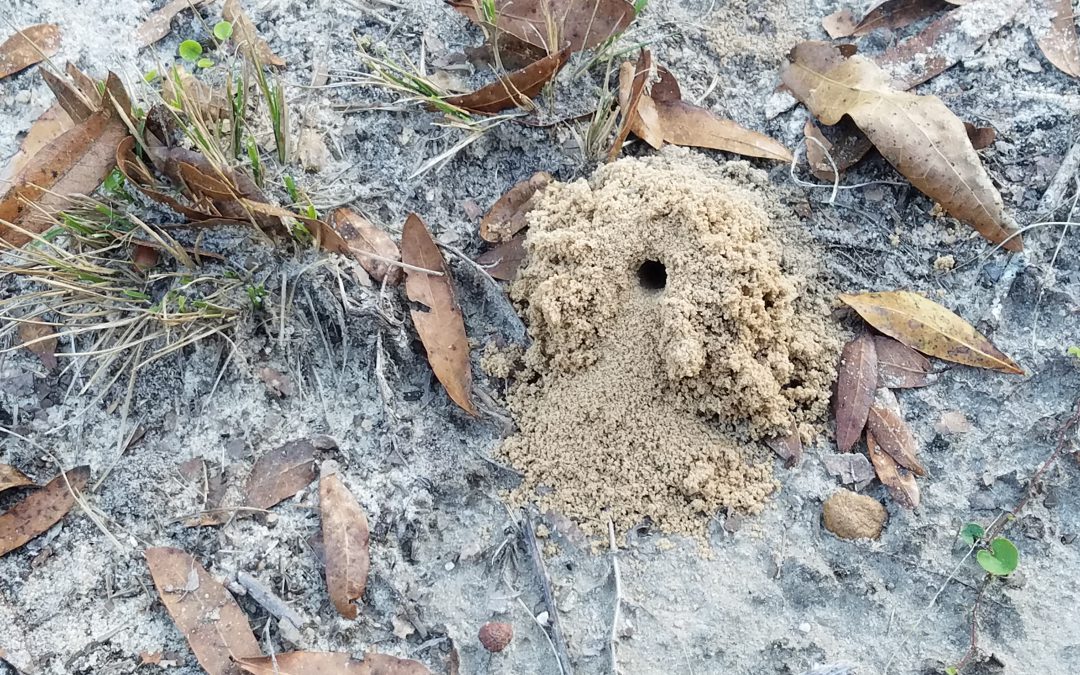
by Evan Anderson | Oct 21, 2021
While most people are familiar with the European honey bee, the domesticated insect that pollinates our crops and provides us with honey, there are plenty of other species of bees and their relatives out there. Most of them are harmless, spending their time quietly pollinating plants, including our crops. Their presence in the landscape, however, may cause some alarm, as it can be difficult for the untrained eye to distinguish between aggressive species and those that are innocuous.
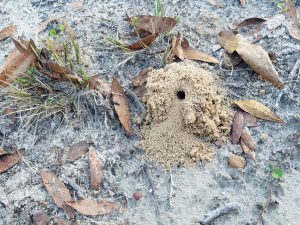
The entrance to a miner bee burrow.
Homeowners may occasionally note small mounds of soil in sandy areas of their lawns. Sometimes sporting a small hole in the center, these are the nesting sites of solitary, ground-nesting bees or hornets. Miner bees or digger bees build underground chambers, usually in well-drained, otherwise bare areas of sandy soil. Multiple bees may choose to dig their nests in the same location, though each bee makes its own tunnel and they do not live communally. Each bee lays her eggs in the nest she has excavated. She gathers pollen to feed the young when they hatch, stocks the larder, and leaves. When the young emerge from the nest, they fly away and do not remain; they will dig their own nests when they are ready to reproduce. While there is no need to control these insects (they serve as fantastic pollinators), the mounds of soil they make may be aesthetically displeasing to some people. Keeping a healthy lawn with no bare patches can deter miner bees from nesting in an area. Irrigation sprinklers can also help to keep the ground moist; these bees prefer dry soil, so it may keep them away. Care must be taken not to over-water a lawn, however!
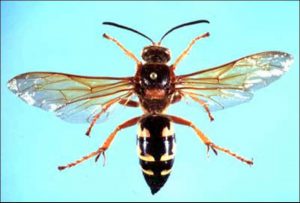
A cicada killer wasp. Photo credit: Division of Plant Industry
Another species of note is the cicada killer hornet. Also known as the giant ground hornet, these insects grow to a size of about an inch and a half in length. Instead of pollen, they capture cicadas to feed their young. Like the miner bee, though, they are not harmful. Females do possess a stinger which they use to hunt their prey. Males may try to warn people or animals away from their burrows by acting aggressive, but they have no stingers. Some may see the large size of the cicada killer and wonder if the so-called “murder hornet” has made its way from Washington state to Florida, but as of this writing it has not. Unless you are a cicada, you have nothing to fear.
One ground-dwelling hornet that does warrant some concern is the yellowjacket. These are communal hornets, living in hives that are often build underground. Yellowjackets are known for their bad attitudes, attacking anyone who disturbs the entrance to their nest. They can be beneficial, being predators of many other insects including plant pests. A colony located too close to human dwellings or areas of activity is most often a nuisance, however. Any attempts to control yellowjacket nests should be done at night when they are less active. Protective clothing is recommended even then. Large or difficult to reach nests may require the attention of a certified pest control company.
For more information on these topics, see our EDIS publications:
Miner Bees: https://edis.ifas.ufl.edu/publication/in912
Cicada Killers: https://edis.ifas.ufl.edu/publication/in573
Yellowjackets: https://edis.ifas.ufl.edu/publication/IN238
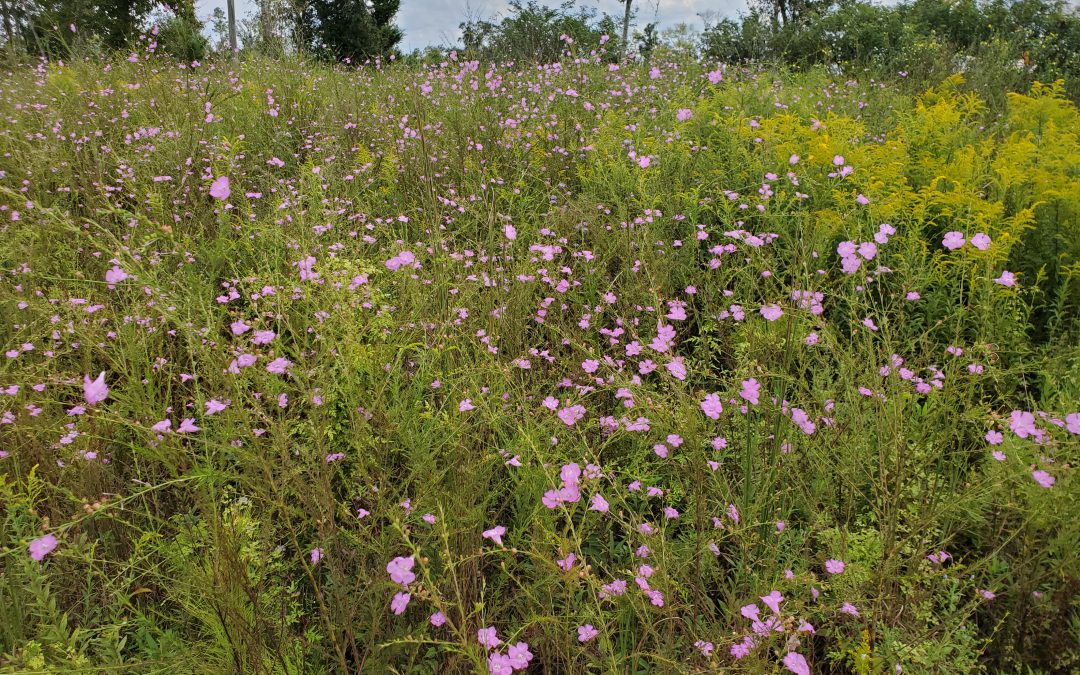
by Daniel J. Leonard | Sep 30, 2021
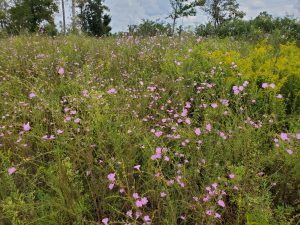
False Foxglove in a Calhoun County natural area. Photo courtesy of Daniel Leonard.
Fall is the absolute best season for wildflower watching in the Panhandle! When mid-September rolls around and the long days of summer finally shorten, giving way to drier air and cooler nights, northwest Florida experiences a wildflower color explosion. From the brilliant yellow of Swamp Sunflower and Goldenrod, to the soothing blue of Mistflower, and the white-on-gold of Spanish Needles, there is no shortage of sights to see from now until frost. But, in my opinion, the star of the fall show is the currently flowering False Foxglove (Agalinus spp.).
Named for the appearance of their brilliant pink flowers, which bear a resemblance to the northern favorite Foxglove (Digitalis spp.), “False Foxglove” is actually the common name of several closely related species of parasitic plants in the genus Agalinus that are difficult to distinguish by all but the keenest of botanists. Regardless of which species you may see, False Foxglove is an unusual and important Florida native plant. Emerging from seed each spring in the Panhandle, plants grow quickly through the summer to a mature height of 3-5’. During this time, False Foxglove is about as inconspicuous a plant as grows. Consisting of a wispy thin woody stem with very small, narrow leaves, plants remain hidden in the flatwoods and sand hill landscapes that they inhabit. However, when those aforementioned shorter September days arrive, False Foxglove explodes into flower sporting sprays of dozens of light purple to pink tubular-shaped flowers that remain until frost ends the season.
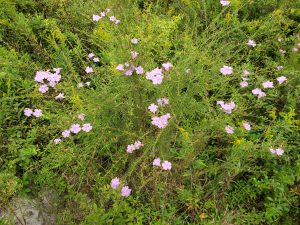
False Foxglove flowering in a Calhoun County natural area. Photo courtesy of Daniel Leonard.
In addition to being unmatched in flower, False Foxglove also plays several important ecological roles in Florida’s natural areas. First, False Foxglove’s relatively large, tubular-shaped flowers are the preferred nectar sources for the larger-sized native solitary and bumble bees present in the Panhandle, though all manner of generalist bees and butterflies will also visit for a quick sip. Second, False Foxglove is the primary host plant for the unique Common Buckeye butterfly. One of the most easily recognizable butterflies due to the large “eye” spots on their wings, Common Buckeye larvae (caterpillars), feed on False Foxglove foliage during the summer before emerging as adults and adding to the fall spectacle. Finally, False Foxglove is an important indicator of a healthy native ecosystem. As a parasitic plant, False Foxglove obtains nutrients and energy by photosynthesis AND by using specialized roots to tap into the roots of nearby suitable hosts (native grasses and other plants). As both False Foxglove and its parasitic host plants prefer to grow in the sunny, fire-exposed pine flatwoods and sand ridges that characterized pre-settlement Florida, you can be fairly confident that if you see a natural area with an abundance of False Foxglove in flower, that spot is in good ecological shape!
The Florida Panhandle is nearly unmatched in its fall wildflower diversity and False Foxglove plays a critical part in the show. From its stunning flowers to its important ecological roles, one would be hard-pressed to find a more unique native wildflower! For more information about False Foxglove and other Florida native wildflowers, contact your local UF/IFAS County Extension office.
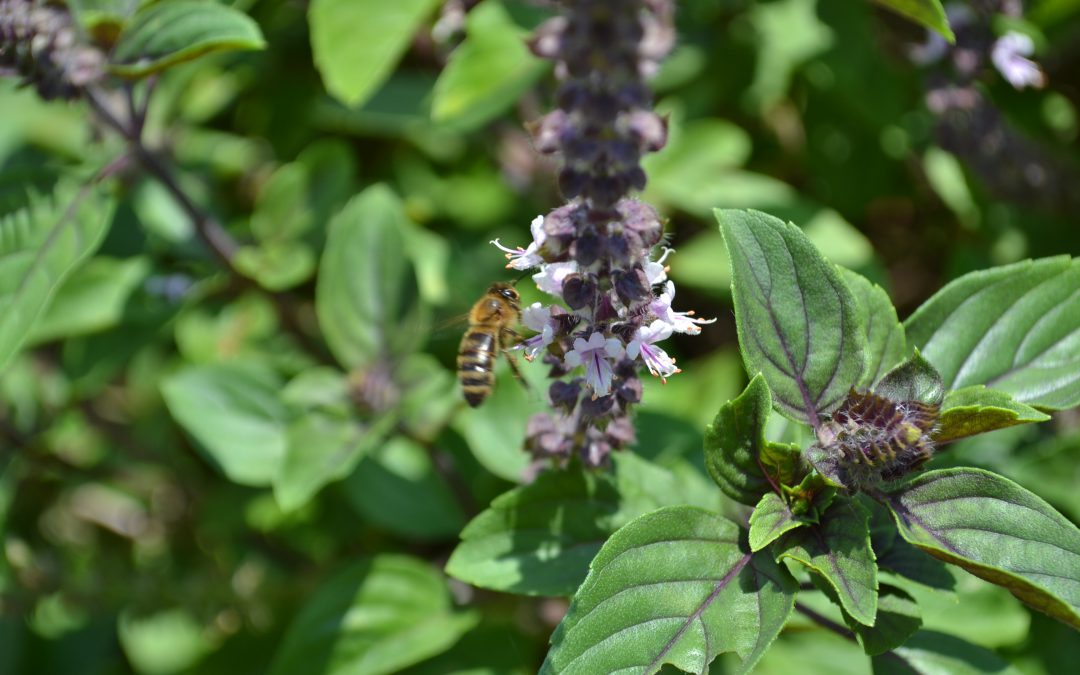
by Beth Bolles | Sep 30, 2021
We hope that you enjoyed the live Q&A with the University of Florida Extension Agent Evan Anderson and Research Coordinator Chris Oster of the UF Honey bee Research and Extension Lab. Below are the questions with the publication links that were provided during the discussion.
What is the best way to get started with a 0.25 acre, residential yard?
How to keep the bee colony in the winter?
How much room should I have for a couple small hives? How many hives should I start with…3?
How much time is involved in the care of the bees and their hive?
Is there a small hive available for a tiny back yard?
What equipment is needed to get started?
Does placing bee hives a certain minimum distance apart help to reduce honey bee colony mortality?
Does Dr. Leo Sharashkin’s Russian concept of horizontal hives fit the environment of the Florida Panhandle?
What is the best treatment for varroa mites?
Identifying behaviors displayed, in order to split the hive. Best time to add supers?
What are good plants for honey bees?
I live near farm fields that use commercial pesticides, can I still bee keep? What are the concerns and how do I mitigate them?
As a first year beekeeper, does all of the rain we’ve experienced this year create any problems that I should be looking for?
Should we be worried about the Asian Giant Hornets in the Florida Panhandle?
We have identified honey bees, cutter bees and carpenter bees in our garden. Should we provide a bee house?
Any killer bees in the area?
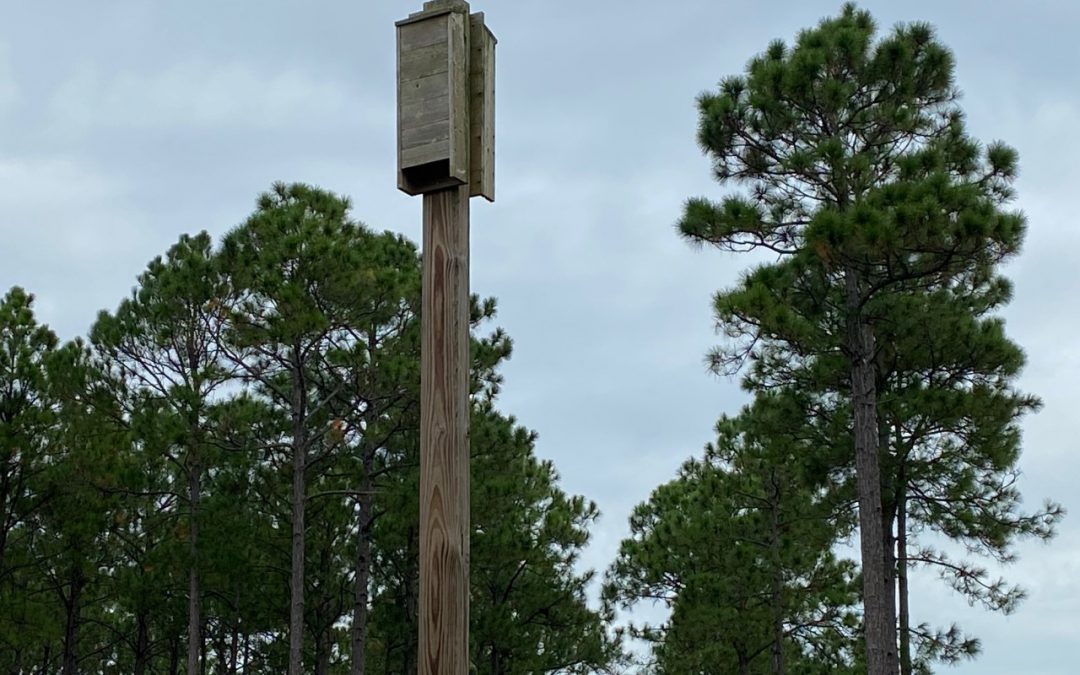
by Stephen Greer | Sep 16, 2021
Bats bring a beneficial component to your property and community. This flying mammal is an exceptional nocturnal feeder of many insect pests and they are important pollinators of many food plants. However, several challenges face this night flyer, like reduced roosting locations, reduced foraging sights, and over use of pesticides.
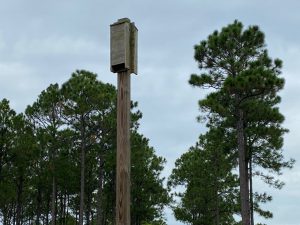
Photo courtesy: Stephen Greer
There are ways to attract bats to your backyard, farm, and community. Placement of bat boxes with ample water sources nearby is a good start. Water sources are another area of importance to attract bats. Have you sat by a swimming pool and witnessed a bat swoop down and skim across the water? It is likely they are either consuming a little water after feeding on a large number of harmful insects or are wetting their modified arms (wings) to help remove dust and dirt to reduce drag on their wings. Bats are the only mammal that are capable of true flight, the modified wings with skin spanning between specific bone structures allows them to accomplish this amazing action.
We often refer to bats as blind, but they can see shadows if out during daylight hours. This poor sight is not helpful enough for survival, this is where their echolocation abilities come into play. Humans studied bats to better understand how they make the sounds that bounce of an object and back to their sensing system that includes exceptional hearing. They locate and consume insects this way. If this sounds familiar, sonar systems were developed by studying this process.
Bats are the major harvester of night-flying insects, many that carry diseases that impact humans and other animals. Insect prey for bats include cockroaches, mosquitos, moths, beetles, gnats and others. A Big Brown Bat can catch and consume 3,000 to 7,000 mosquitos a night. Multiple this by a large bat population the amount of harmful insects harvested can go into the thousands of tons in a year. This is a positive impact for our forest and agriculture lands against major pests.
Florida is home to 13 different species of bats. They are always on the hunt for warm, dry, dark areas that are either natural or manmade narrow crevices. Out of all of these species, 4 bats are the primary inhabitants of bat houses. The Evening Bat and Brazilian free-tailed Bat are the most common in the panhandle of Florida. The Big Brown Bat and Southeastern Bat can at times occupy houses.
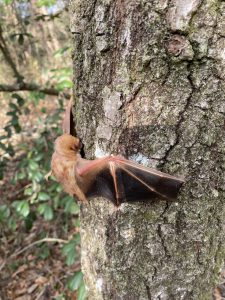
Photo courtesy: Matt Lollar
You can often locate bats boxes at your garden and agriculture centers or order online. Another option is to build your own boxes. Just remember the best way to erect a bat box is on a tall post. It is recommended to set the boxes around 10 feet off the ground. Placing boxes on trees creates a setting for potential predators to approach and feed on bats. Snakes have been known to enter and feed on young bats that are not fully developed and at best are poor fliers.
As a reminder, never touch a bat or any other wild animals. Bats that are healthy are not found on the ground, so assume the bat is not health and may be carrying a disease. On a final note, enjoy sitting on the back porch and watching the acrobatics of these amazing mammals in the evening sky.
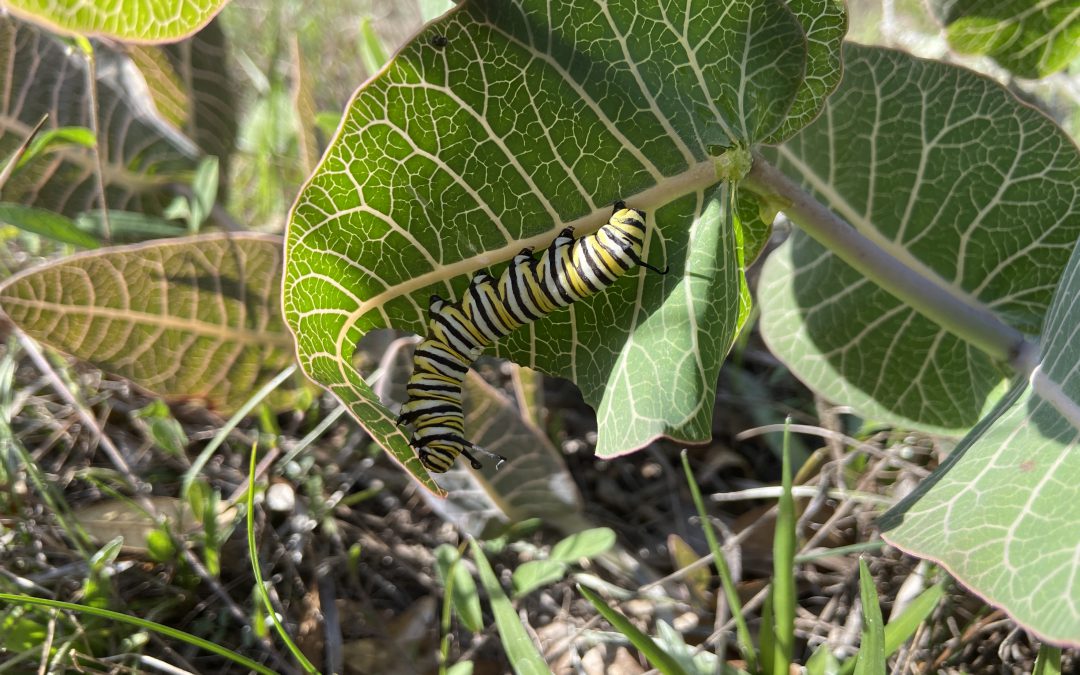
by Mary Salinas | Aug 20, 2021
On August 12, 2021, our panel answered questions on a wide variety of landscape topics. Maybe you are asking the same questions, so read on!
Ideas on choosing plants
What are some perennials that can be planted this late in the summer but will still bloom through the cooler months into fall?
Duranta erecta ‘Sapphire Showers’ or ‘Gold Mound’, firespike, Senna bicapsularis, shrimp plant, lion’s ear
Where can native plants be obtained?
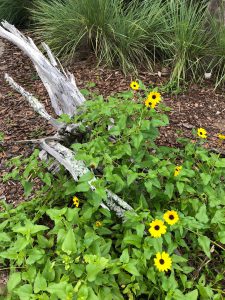
Dune sunflower, Helianthus debilis. Photo credit: Mary Salinas UF/IFAS Extension.
Gardening Solutions: Florida Native Plants – see link to FANN: https://gardeningsolutions.ifas.ufl.edu/plants/ornamentals/native-plants.html
What are some evergreen groundcover options for our area?
Mondo grass, Japanese plum yew, shore juniper, ajuga, ferns such as autumn fern.
What are some ideas for partial morning sun butterfly attracting tall flowers to plant now?
Milkweed, salt and pepper plant, swamp sunflower, dune sunflower, ironweed, porterweed, and salt bush.
I’m interested in moving away from a monoculture lawn. What are some suggestions for alternatives?
Perennial peanut, powderpuff mimosa, and frogfruit.
We are new to Florida and have questions about everything in our landscape.
Florida-Friendly-Landscaping TM Program and FFL Web Apps: https://ffl.ifas.ufl.edu/
https://ffl.ifas.ufl.edu/resources/apps/
UF IFAS Gardening Solutions: https://gardeningsolutions.ifas.ufl.edu/
What are some of the top trends in landscaping today?
Houseplants, edible gardens, native plants, food forests, attracting wildlife, container gardening, and zoysiagrass lawns
Edibles
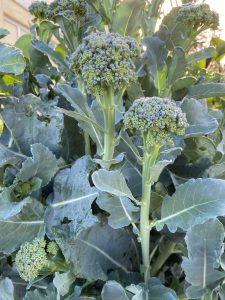
Artwork broccoli is a variety that produces small heads. Photo credit: Mary Salinas UF/IFAS Extension.
What vegetables are suitable for fall/winter gardening?
Cool Season Vegetables: https://gardeningsolutions.ifas.ufl.edu/plants/edibles/vegetables/cool-season-vegetables.html
North Florida Gardening Calendar: https://edis.ifas.ufl.edu/publication/EP451%20%20%20
Florida Vegetable Gardening Guide: https://edis.ifas.ufl.edu/publication/vh021
How can I add herbs to my landscape?
Herbs in the Florida Garden: https://gardeningsolutions.ifas.ufl.edu/plants/edibles/vegetables/herbs.html
My figs are green and hard. When do they ripen?
Why Won’t My Figs Ripen: https://www.lsuagcenter.com/profiles/rbogren/articles/page1597952870939
What is best soil for raised bed vegetable gardens?
Gardening in Raised Beds: https://edis.ifas.ufl.edu/publication/EP472
And there are always questions about weeds
How can I eradicate cogongrass?
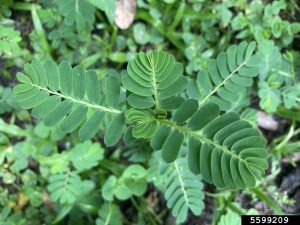
Chamber bitter is a troublesome warm season weed in our region. Photo credit: Brantlee Spakes Richter, University of Florida, Bugwood.org
Cogongrass: https://edis.ifas.ufl.edu/publication/WG202
Is it okay to use cardboard for weed control?
The Cardboard Controversy: https://gardenprofessors.com/the-cardboard-controversy/
What is the best way to control weeds in grass and landscape beds?
Weed Management Guide for Florida Lawns: https://edis.ifas.ufl.edu/publication/EP141
Improving Weed Control in Landscape Planting Beds: https://edis.ifas.ufl.edu/pdf/EP/EP52300.pdf
Landscape practices
Can ground water be brackish and stunt plants?
Reclaimed Water Use in the Landscape: https://edis.ifas.ufl.edu/publication/ss545
How can I prevent erosion from rainwater runoff?
Stormwater Runoff Control – NRCS: https://www.nrcs.usda.gov/wps/portal/nrcs/detail/national/water/?cid=nrcs144p2_027171
Rain Gardens: https://gardeningsolutions.ifas.ufl.edu/design/types-of-gardens/rain-gardens.html
And https://gardeningsolutions.ifas.ufl.edu/pdf/articles/rain-garden-manual-hillsborough.pdf
What is the best time of the year to propagate flowering trees in zone 8B?
Landscape Plant Propagation Information Page – UF/IFAS Env. Hort: https://hort.ifas.ufl.edu/database/lppi/
Which type of mulch works best on slopes greater than 3 percent?
Landscape Mulches: How Quickly do they Settle?: https://edis.ifas.ufl.edu/publication/FR052
When should bulbs be fertilized?
Bulbs and More – UI Extension: https://web.extension.illinois.edu/bulbs/planting.cfm
Should I cut the spent blooms of agapanthus?
Agapanthus, extending the bloom time: https://gardeningsolutions.ifas.ufl.edu/plants/ornamentals/agapanthus.html
http://blogs.ifas.ufl.edu/wakullaco/2020/10/07/extending-bloom-time/
Plant questions
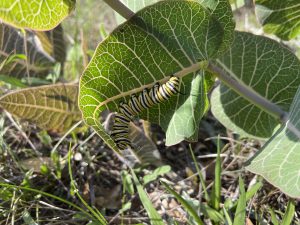
Monarch caterpillar munching on our native sandhill milkweed, Asclepias humistrata. Photo credit: Mary Salinas, UF IFAS Extension.
I planted native milkweed and have many monarch caterpillars. Should I protect them or leave them in nature?
It’s best to leave them in place. Featured Creatures: Monarch Butterfly: https://edis.ifas.ufl.edu/pdf/IN/IN780/IN780-Dxyup8sjiv.pdf
How does Vinca (periwinkle) do in direct sun? Will it make it through one of our panhandle summers? Can I plant in late August?
Periwinkles and No more fail with Cora series: https://gardeningsolutions.ifas.ufl.edu/plants/ornamentals/periwinkles.html#:~:text=Plant%20your%20periwinkles%20where%20they,rot%20if%20irrigated%20too%20frequently.
Insect and disease pests
What to do if you get termites in your raised bed?
The Facts About Termites and Mulch: https://edis.ifas.ufl.edu/publication/IN651
How to combat fungus?
Guidelines for ID and Management of Plant Disease Problems: https://edis.ifas.ufl.edu/publication/mg442
Are there preventative measures to prevent diseases when the humidity is very high and it is hot?
Fungi in Your Landscape by Maxine Hunter: http://blogs.ifas.ufl.edu/marionco/2020/01/16/fungi-in-your-landscape/
If you missed an episode, check out our playlist on YouTube https://www.youtube.com/watch?v=bp0HfdEkIQw&list=PLhgoAzWbtRXImdFE8Jdt0jsAOd-XldNCd
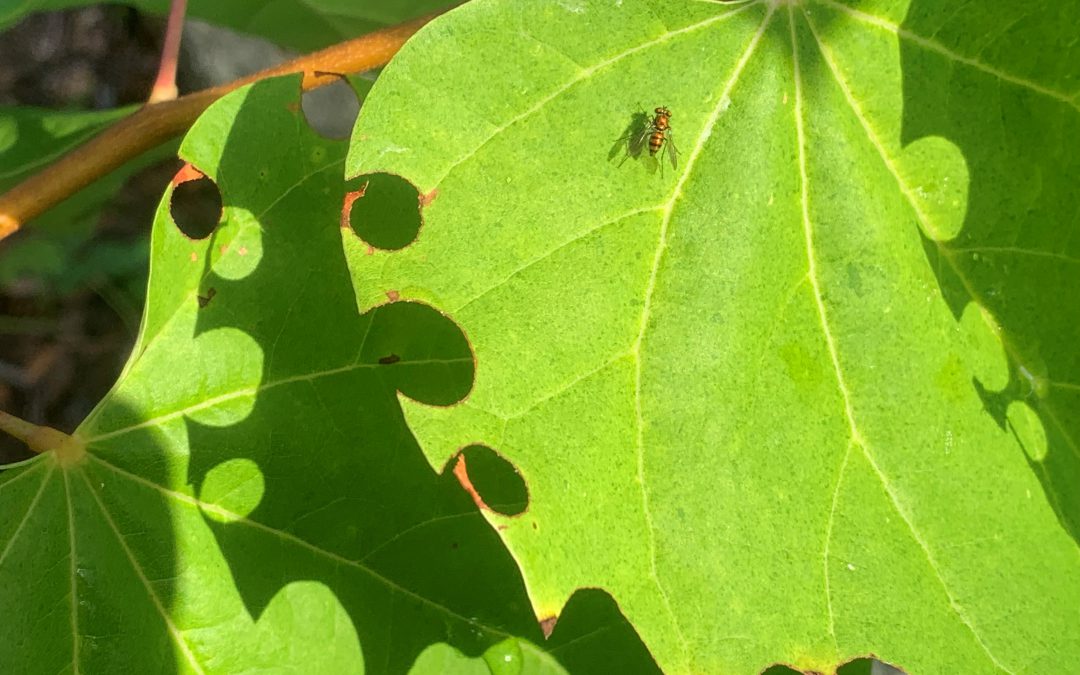
by Beth Bolles | Aug 18, 2021
In a garden with a variety of flowers, pollinators will be abundant. Sometimes we don’t always recognize the specific pollinator when we see it, but there are some native pollinators that leave other signs of their activity. One of our medium-sized native bees will leave a distinctive calling card of recent activity in our landscape.
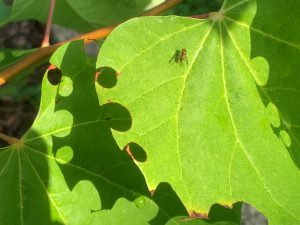
Leafcutter bees have collected circular notches from the edges of a redbud tree. Photo by Beth Bolles, UF IFAS Extension Escambia County.
If you see some of the leaves of trees and shrubs with distinct circular notches on the edges of the leaves, you can be sure the Leafcutter bee is present. The females collect the leaf pieces to make a small, cigar-shaped nest that may be found in natural cavities, such as rooting wood, soil, or in plant stems. Each nest will have several sections in which the female places a ball of pollen and an egg. The emerging larvae then have a plentiful food source in order to develop into an adult bee.
When identifying a leafcutter bee in your landscape, look for a more robust bee with dark and light stripes on the abdomen. These bees also have a hairy underside to their abdomen where they carry the pollen. When loaded with pollen their underside will look yellow.
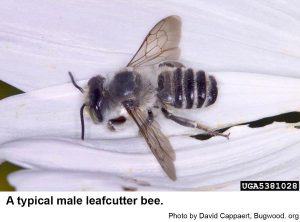 Leafcutter bees are solitary bees that are not considered aggressive. A sting would only be likely if the bee is handled. Your landscape will have many plants that a leafcutter may use for nesting material. The pollinating benefits of these bees far outweigh any cosmetic injury to the plant leaf margins.
Leafcutter bees are solitary bees that are not considered aggressive. A sting would only be likely if the bee is handled. Your landscape will have many plants that a leafcutter may use for nesting material. The pollinating benefits of these bees far outweigh any cosmetic injury to the plant leaf margins.
Visit Featured Creatures to see a photo of the leaf pieces made into a nest.


















